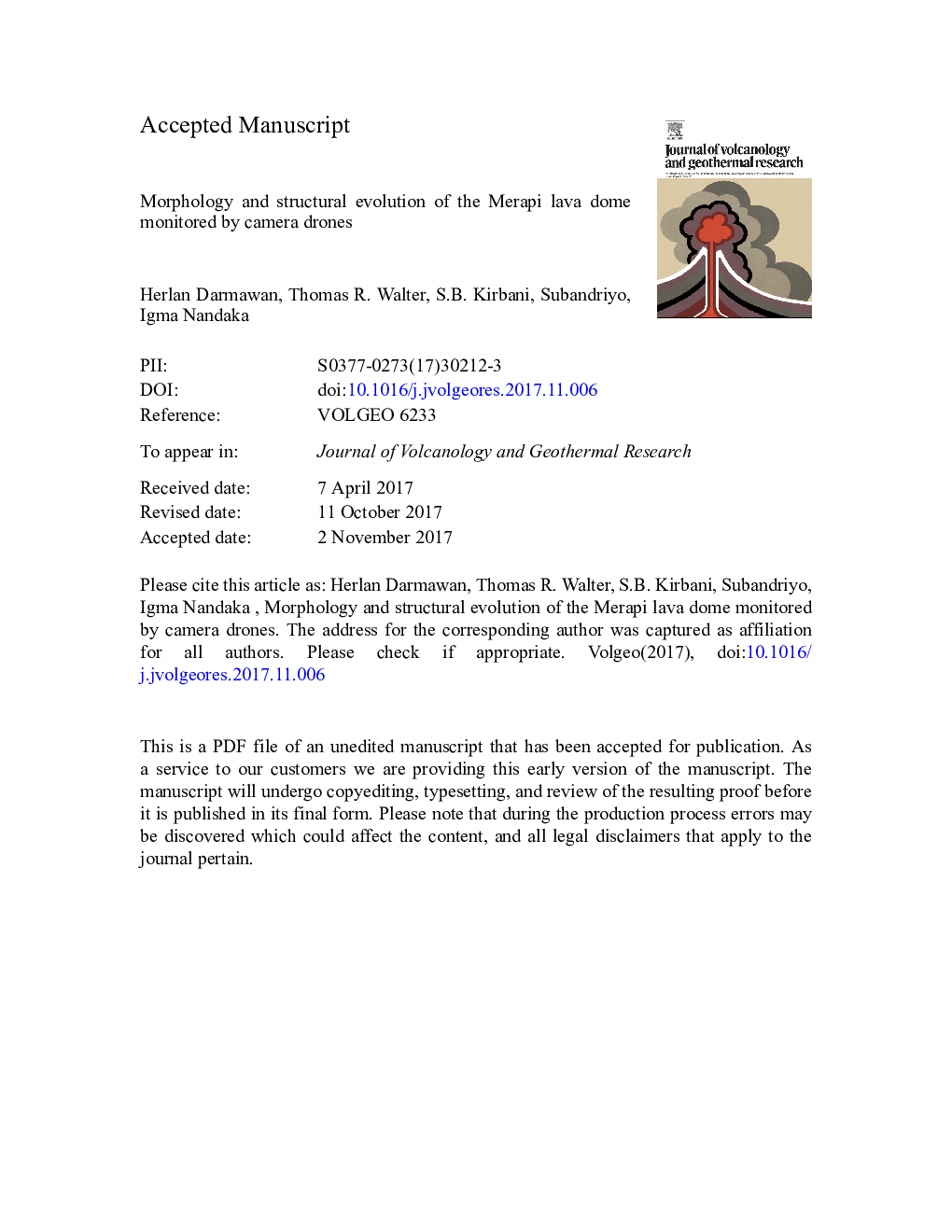| کد مقاله | کد نشریه | سال انتشار | مقاله انگلیسی | نسخه تمام متن |
|---|---|---|---|---|
| 8911430 | 1638274 | 2018 | 33 صفحه PDF | دانلود رایگان |
عنوان انگلیسی مقاله ISI
Morphological and structural changes at the Merapi lava dome monitored in 2012-15 using unmanned aerial vehicles (UAVs)
ترجمه فارسی عنوان
تغییرات مورفولوژیکی و ساختاری در گنبد گدازه مراپی در سال 2012-15 با استفاده از وسایل نقلیه بدون سرنشین (هواپیماهای بدون سرنشین)
دانلود مقاله + سفارش ترجمه
دانلود مقاله ISI انگلیسی
رایگان برای ایرانیان
کلمات کلیدی
فتوگرامتری، مدل ارتفاع دیجیتال، ساختار از حرکت، آتشفشان مراپی، گنبد گدازه توپوگرافی، نظارت آتشفشان،
موضوعات مرتبط
مهندسی و علوم پایه
علوم زمین و سیارات
ژئوشیمی و پترولوژی
چکیده انگلیسی
Dome-building volcanoes undergo rapid and profound topographic changes that are important to quantify for the purposes of hazard assessment. However, as hazardous lava domes often develop on high-altitude volcanoes that exhibit steep-sided topography, it is challenging to obtain direct field access and thus to analyze these morphological and structural changes. Merapi Volcano in Indonesia is a type example of such a volcano, as soon after its 2010 eruption, a new lava dome developed. This dome was partially destroyed during six distinct steam-driven explosions that occurred between 2012 and 2014. Here, we investigate the topographic and structural changes associated with these six steam-driven explosions by comparing close-range photogrammetric data obtained before and after these explosions. To accomplish this, we performed two UAV campaigns in 2012 and 2015. By applying the Structure from Motion (SfM) technique, we are able to construct three-dimensional point clouds, assess their quality by comparing them to a terrestrial laser scanning (TLS) dataset, and generate high-resolution Digital Elevation Models (DEMs) and photomosaics. The comparison of these two DEMs and photomosaics reveals changes in topography and the appearance of fractures. In the 2012 dataset, we find a dense fracture network striking to the NNW-SSE. In the post-eruptive 2015 dataset, we see that this NNW-SSE fracture trend is much more strongly expressed; we also detect the formation of aligned and elongated explosion craters, which are associated with the removal of over 200,000Â m3 of dome material, most of which (~70%) was deposited outside the crater region. Therefore, this study suggests that the locations of the steam-driven explosions at Merapi Volcano were controlled by the reactivation of preexisting structures. Moreover, some of the newly developed and reactivated fractures delineate a block on the southern slope of the dome, which could become structurally unstable and potentially lead to rock avalanche hazards. This study therefore demonstrates the significance of characterizing structural fingerprints during the development of lava domes and exemplifies the value of topographic and fracture mapping, which is becoming increasingly feasible when using UAVs, even on high and steep stratovolcanoes.
ناشر
Database: Elsevier - ScienceDirect (ساینس دایرکت)
Journal: Journal of Volcanology and Geothermal Research - Volume 349, 1 January 2018, Pages 256-267
Journal: Journal of Volcanology and Geothermal Research - Volume 349, 1 January 2018, Pages 256-267
نویسندگان
Herlan Darmawan, Thomas R. Walter, Kirbani Sri Brotopuspito, Subandriyo Subandriyo, I Gusti Made Agung Nandaka I Gusti Made Agung Nandaka,
